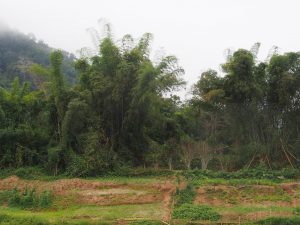Session B-05 (26): Approaches for Sustaining Agroforestry Systems and Practice in Asia and Oceania
Moderator: Swoyambhu Man Amatya, Coordinator IUFRO Division 1.04.00, Ministry of Forests and Soil Conservation, Nepal
Wednesday, 26th of October 2016, 10:30-12:30 (301 B)
Find more information on the IUFRO Division 1.04.00 Agroforestry at:
http://www.iufro.org/science/divisions/division-1/10000/10400/

Agroforestry area in Laos. Photo: Renate Prüller, IUFRO Headquarters
While undernourishment decreased globally, agriculture has intensified. Agroforestry systems are believed to reduce negative impacts of farming, by enhancing ecosystem services without hindering the yield of farmers. This session explored agroforestry systems currently used in Asia and Oceania as well as the potential role of agroforestry in securing food, livelihoods and mitigation of climate change effects.
Many studies report about economic and ecological benefits of agroforestry. Systematic reviewing can help to develop evidence based practices and aid with policy decisions. However, potentials need to be assessed on a local scale, considering site conditions as well as social parameters.
A great resource for developing agroforestry systems can be found in traditional knowledge of agriculture as well as in utilisation of non-timber forest products (NTFP). The combination of traditional knowledge and innovative research i.e. on interaction of species, genetics and treatment regimens are the way forward to improve yield and resilience.
Agroforestry is a field with high potential, not only in aiding to make agricultural ventures more resilient, but also in taking pressure of forests by seeking ways to a domesticate forest products.
Presentations in this session:
Possibility Of Cultivating Andrographis Paniculata Under Emblica Officinalis Trees In Drylands Of Sub Montane North Western (Sandeep Sehgal, India)
How Effective Are On-Farm Pro-Conservation Management Strategies For Preserving Ecosystem Services in Asia? (Gillian Petrokofsky, University of Oxford, United Kingdom)
Trees And Non-Timber Forest Products In Agroforestry And Home Gardens In SE Asia – Case Studies And The Role Of Research (Bernard Dell, Murdoch University, Australia)
Introduce Of Camellia Oleifera And Study Of The Seedlings Propagation Technology (Yuan Tingting, China)
Continuous Fertilization Time Indicates Different Effects On Forest Carbon Stocks: Evidence From Phyllostachys Pubescens Forest In Subtropical Southern China (Shi Lei, International Centre for Bamboo and Rattan, China)

Leave a Reply